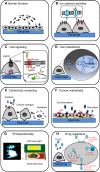Drug and bioactive molecule screening based on a bioelectrical impedance cell culture platform
- PMID: 25525360
- PMCID: PMC4266242
- DOI: 10.2147/IJN.S71128
Drug and bioactive molecule screening based on a bioelectrical impedance cell culture platform
Abstract
This review will present a brief discussion on the recent advancements of bioelectrical impedance cell-based biosensors, especially the electric cell-substrate impedance sensing (ECIS) system for screening of various bioactive molecules. The different technical integrations of various chip types, working principles, measurement systems, and applications for drug targeting of molecules in cells are highlighted in this paper. Screening of bioactive molecules based on electric cell-substrate impedance sensing is a trial-and-error process toward the development of therapeutically active agents for drug discovery and therapeutics. In general, bioactive molecule screening can be used to identify active molecular targets for various diseases and toxicity at the cellular level with nanoscale resolution. In the innovation and screening of new drugs or bioactive molecules, the activeness, the efficacy of the compound, and safety in biological systems are the main concerns on which determination of drug candidates is based. Further, drug discovery and screening of compounds are often performed in cell-based test systems in order to reduce costs and save time. Moreover, this system can provide more relevant results in in vivo studies, as well as high-throughput drug screening for various diseases during the early stages of drug discovery. Recently, MEMS technologies and integration with image detection techniques have been employed successfully. These new technologies and their possible ongoing transformations are addressed. Select reports are outlined, and not all the work that has been performed in the field of drug screening and development is covered.
Keywords: electric cell-substrate impedance sensing (ECIS); high-throughput screening; impedance-based cell study; real-time drug evaluation; screening of bioactive agents.
Figures





References
-
- Giaever I, Keese CR. A morphological biosensor for mammalian cells. Nature. 1993;366(6455):591–592. - PubMed
-
- Ehret R, Baumann W, Brischwein M, Schwinde A, Stegbauer K, Wolf B. Monitoring of cellular behaviour by impedance measurements on interdigitated electrode structures. Biosens Bioelectron. 1997;12(1):29–41. - PubMed
-
- Grimnes S, Martinsen OG. Bioimpedance and Bioelectricity Basics. 1st ed. St Louis, MO: 2000.
-
- Xu Y, Lv Y, Wang L, Xing W, Cheng J. A microfluidic device with passive air-bubble valves for real-time measurement of dose-dependent drug cytotoxicity through impedance sensing. Biosens Bioelectron. 2012;32(1):300–304. - PubMed
Publication types
MeSH terms
LinkOut - more resources
Full Text Sources
Other Literature Sources

